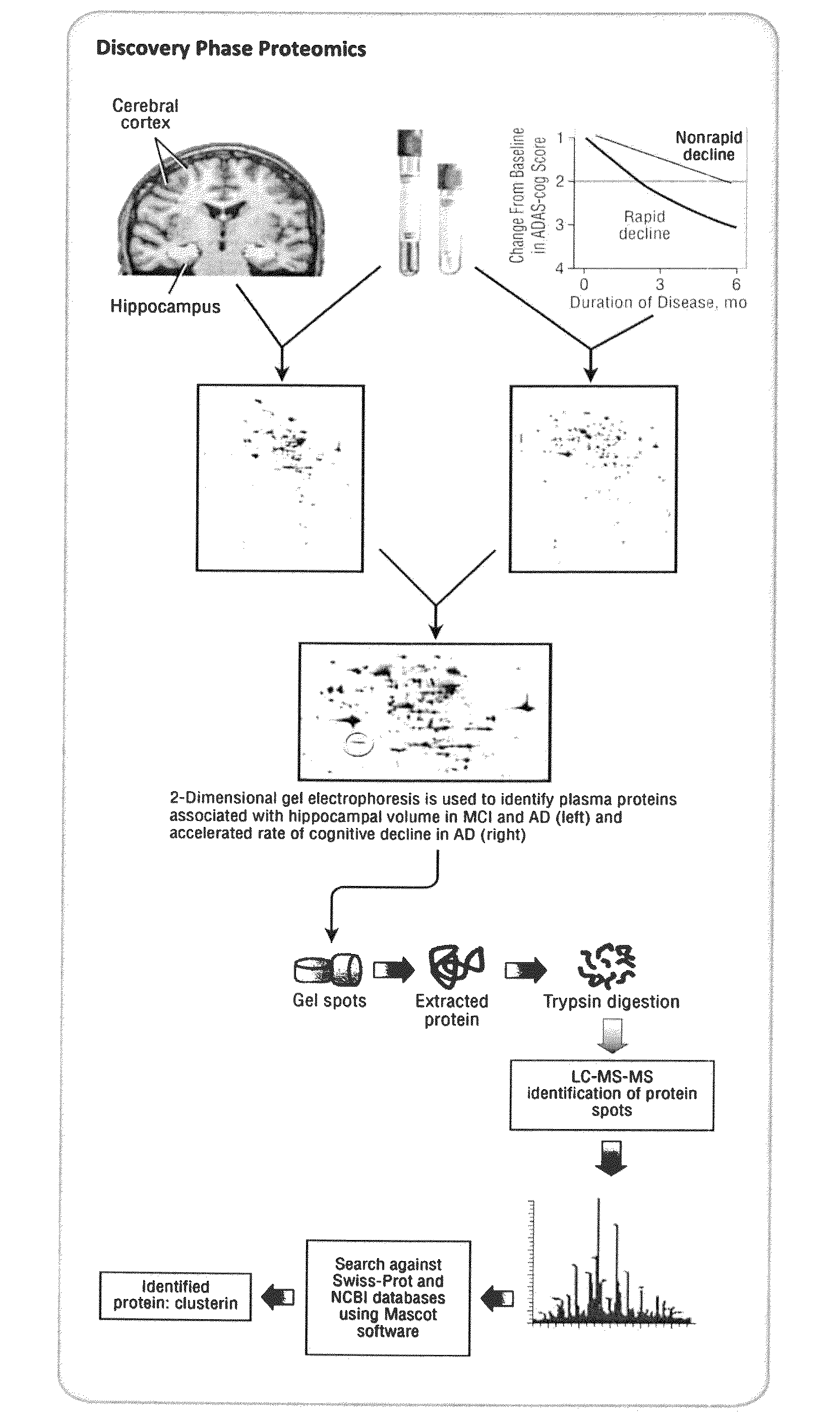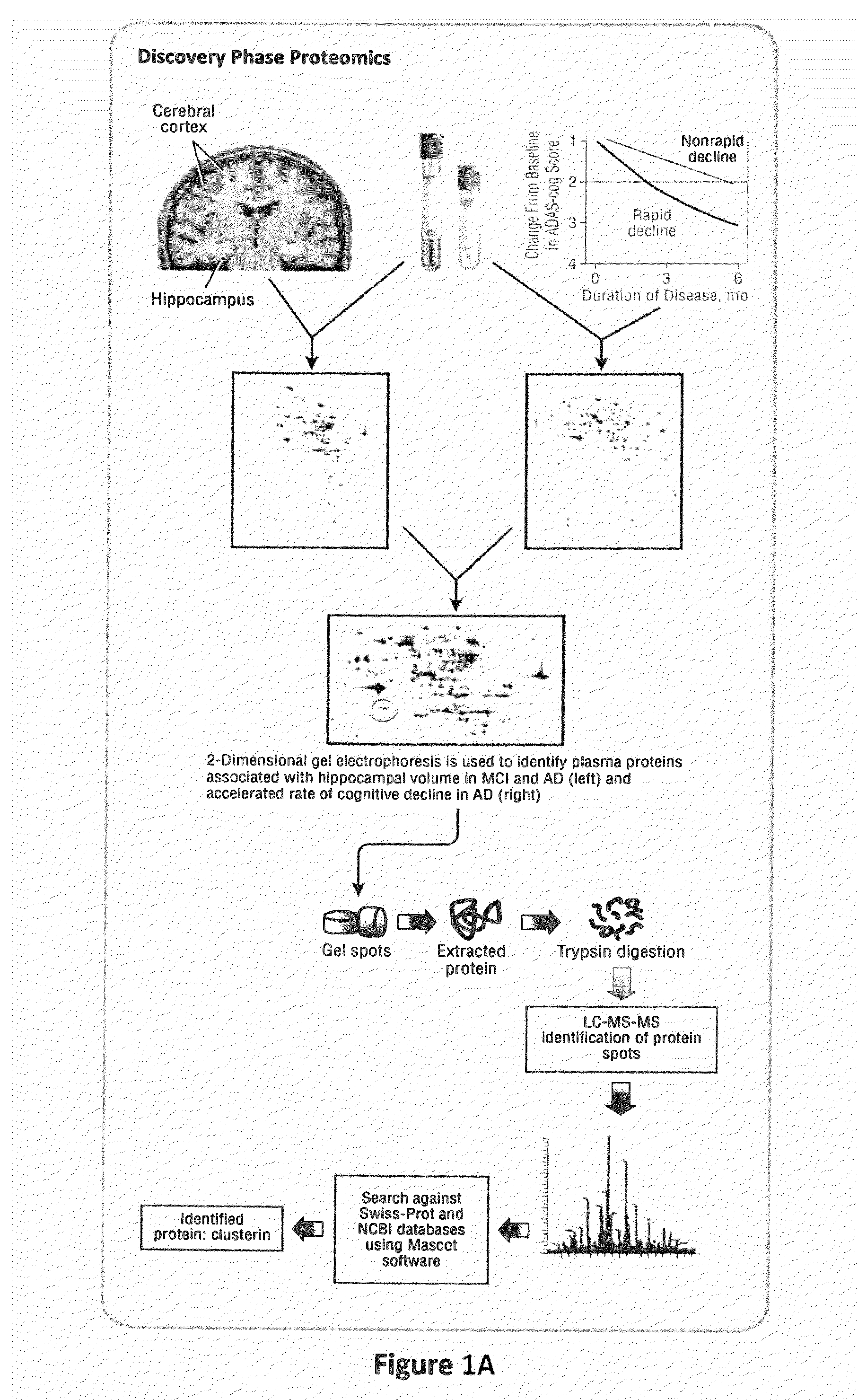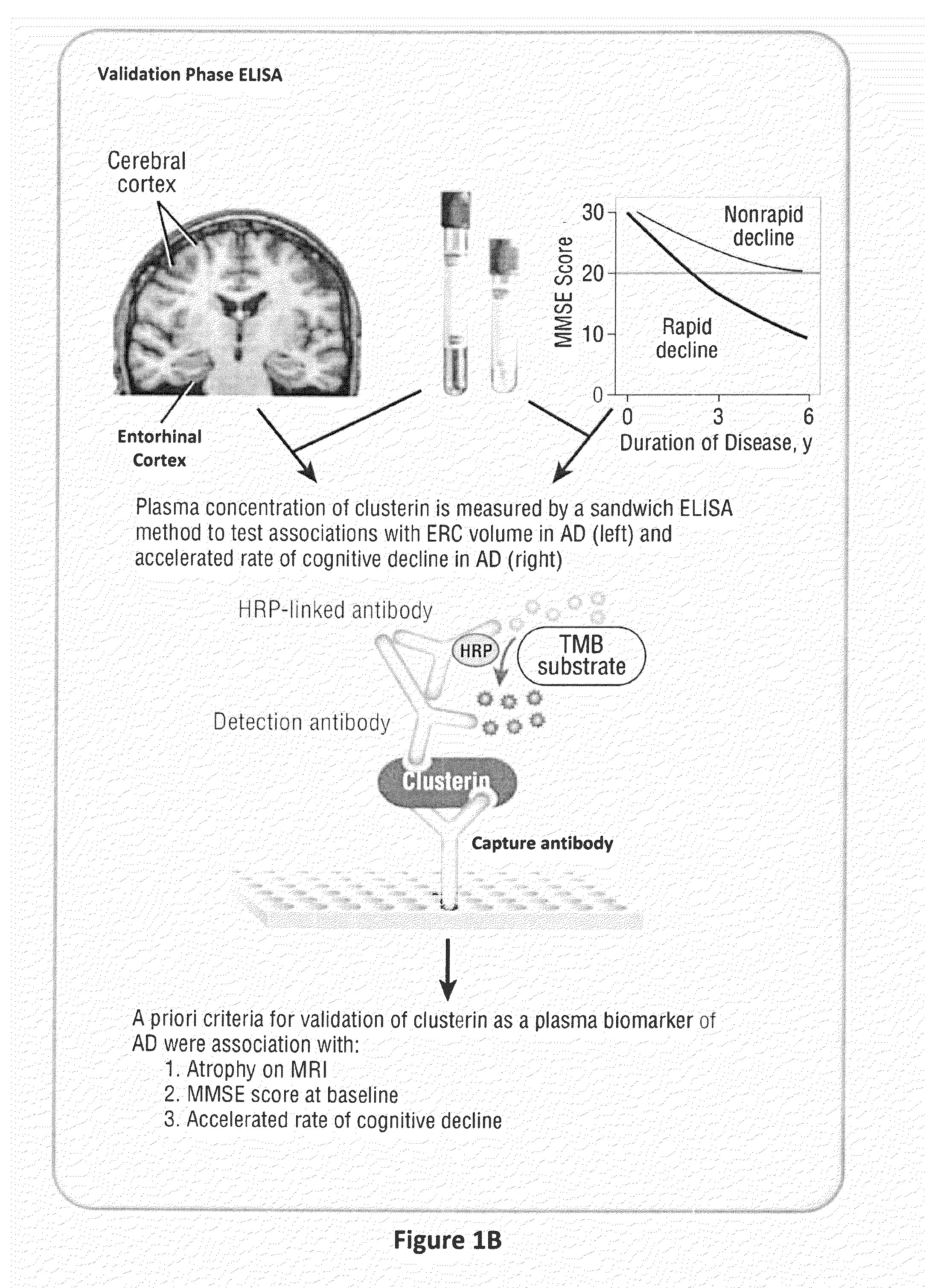Markers and methods relating to the assessment of alzheimer's disease
a technology for alzheimer's disease and alzheimer's disease, applied in the field of alzheimer's disease severity, progression and pathology assessment, can solve the problems of clusterin concentration, brain atrophy, cognitive impairment, and speed of progression of ad, and achieve severe brain pathology, severe cognitive impairment, and pronounced clinical and/or pathological sta
- Summary
- Abstract
- Description
- Claims
- Application Information
AI Technical Summary
Benefits of technology
Problems solved by technology
Method used
Image
Examples
example 1
Proteomic Identification of Plasma Proteins Associated with Hippocampal Atrophy and Rapid Clinical Progression in AD
[0083]Using 2DGE and LC-MS / MS we identified a set of proteins in plasma that showed significant correlation with hippocampal atrophy in a combined group of 44 subjects representing a continuum of disease; 27 with mild to moderate AD and 17 with MCI (see Table 1 below).
TABLE 1Discovery-phase SubjectsRate of clinicalHippocampal volume studyprogression studyRapidNon-rapidADMCIdeclinersdecliners(n = 27)(n = 17)(n = 22)(n = 29)Gender (M / F)9 / 187 / 109 / 1311 / 18Age (years)78(4.0)77(6.0)76(7.1)79(6.8)Disease4.8(3.5)n / a4.1(3.3)5.0(4.0)duration (years)MMSE22(3.9) ‡26(2.1)20.7(4.3)20.9(5.2)Total5.82(1.40) *6.96(1.25)n / an / ahippocampalvolume (mL)Rate ofn / an / a7.95(5.2) §−3.3(4.5)decline inADAS-Cog scoreValues are expressed as mean ± (SD)‡ differs from MCI; p * differs from MCI; p = 0.01§ Differs from non-rapid decliners; p
[0084]Bivariate correlation of integrated optical densities of s...
example 2
Clusterin is Associated with Atrophy of the Entorhinal Cortex, Severity of Cognitive Impairment and Speed of Progression in AD
[0085]Only one protein was identified as a potential AD biomarker from both discovery phase studies—clusterin. We therefore validated the plasma clusterin finding in a large cohort of 689 subjects; 344 with neuroimaging from the AddNeuroMed study (119 with AD, 115 with MCI and 110 controls) and 345 with AD from a long term biomarker study—the KCL ART cohort (see Tables 2a and 2b below).
TABLE 2aValidation-phase Subjects: AddNeuroMedcohort (Neuro-imaging studies)ADMCIControl(n = 119)(n = 115)(n = 110)Gender (M / F)41 / 7859 / 5650 / 60Age (years)75.6(6.4) *74.5(5.6)72.9(6.7)MMSE20.8(4.7) § ‡26.9(3.0) §29.1(1.2)ERC thick-2.6(0.52) §, ‡3.0(0.49) §3.3(0.35)ness (mm)Values are expressed as mean ± (SD)* Differs from control; p = 0.003§ Differs from control; p ‡ Differs from MCI; p
TABLE 2bCombined ART and AddNeuromed Cohorts - AD fast vs. AD slow declinersRetrospective decl...
example 3
Gene Expression of Clusterin is Altered in AD
[0093]In order to investigate the possible mechanisms underlying the observed associations between plasma concentration of clusterin and both imaging measures of atrophy and accelerated clinical progression, we measured clusterin mRNA levels in blood cells from AD patients, MCI subjects and controls (see Table 3 below).
TABLE 3Characteristics of subjects included inthe clusterin gene expression studyADMCIControl(n = 182)(n = 179)(n = 207)Gender (M / F)59 / 12379 / 10083 / 123Age (years)77.2(6.8)*‡75.3 (6.2)73.7 (7.1)Disease4.4(3.0)duration (years)MMSE20.6(4.9)‡§ 27.0 (2.8)§28.5 (3.2)Values are expressed as mean ± (SD)*Differs from control; p = 0.005‡Differs from MCI; p §Differs from control; p
[0094]Diagnosis had a significant effect on clusterin gene expression (ANCOVA; df=2; P<0.001 and age as covariate). Pairwise comparisons between the three groups showed significantly higher clusterin gene expression in AD than MCI and control subjects (P=0.0...
PUM
| Property | Measurement | Unit |
|---|---|---|
| Fraction | aaaaa | aaaaa |
| Time | aaaaa | aaaaa |
| Time | aaaaa | aaaaa |
Abstract
Description
Claims
Application Information
 Login to View More
Login to View More - R&D
- Intellectual Property
- Life Sciences
- Materials
- Tech Scout
- Unparalleled Data Quality
- Higher Quality Content
- 60% Fewer Hallucinations
Browse by: Latest US Patents, China's latest patents, Technical Efficacy Thesaurus, Application Domain, Technology Topic, Popular Technical Reports.
© 2025 PatSnap. All rights reserved.Legal|Privacy policy|Modern Slavery Act Transparency Statement|Sitemap|About US| Contact US: help@patsnap.com



